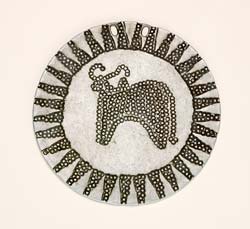
Domestic cattle, particularly in eastern Africa, are wealth on the hoof and central to the lives of peoples involved with them. Their horns may be forced to grow into "perfect" shapes; the color of their hides is the subject of discourse; poems are written in their honor; and jewelry in a variety of materials is made for the bovines as well as the people who own them. In West Africa, a physically mature young Bijogo man wears the mask of Dugn'be, "the ox raised in the village". He is still considered to be learning the proper behavior of an adult, much like the ox with a lead string through its nose.
 The west African buffalo or bush cow is a wild animal, powerful and possibly dangerous. Carvings of this animal into large community-owned slit gongs that can sound alerts and gather men armed to fight indicate the buffalo's power can be harnessed for the good of the community. The buffalo is often a symbol of a ruler or his enforcers. In the kingdoms of the Cameroon Grassfields, members of the palace regulatory society who captured wrongdoers and acted as judges wore buffalo masks. The buffalo was the personal emblem of two Fon kings in the old kingdom of Dahomey: King Tegbesu used the image of a buffalo wearing a cloak in the 18th century and King Ghezo (reign 1818-58) used the buffalo without the cloak as his emblem. The west African buffalo or bush cow is a wild animal, powerful and possibly dangerous. Carvings of this animal into large community-owned slit gongs that can sound alerts and gather men armed to fight indicate the buffalo's power can be harnessed for the good of the community. The buffalo is often a symbol of a ruler or his enforcers. In the kingdoms of the Cameroon Grassfields, members of the palace regulatory society who captured wrongdoers and acted as judges wore buffalo masks. The buffalo was the personal emblem of two Fon kings in the old kingdom of Dahomey: King Tegbesu used the image of a buffalo wearing a cloak in the 18th century and King Ghezo (reign 1818-58) used the buffalo without the cloak as his emblem.

Ring
Dinka peoples, Malakal area, Sudan
Early to mid-20th century
Ivory
Bequest of Eliot Elisofon, 73-7-777
|

Man's pendant with bovine
Shilluk peoples, Malakal area, Sudan
c. 1947
Aluminum
Bequest of Eliot Elisofon, 73-7-750
|
|
|
|